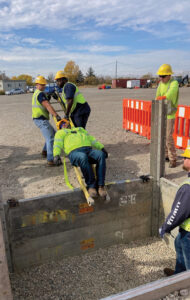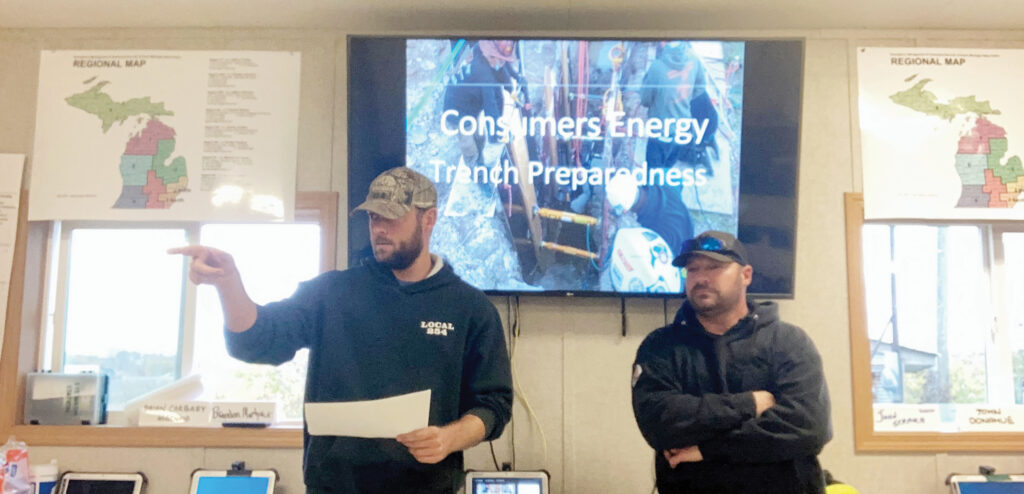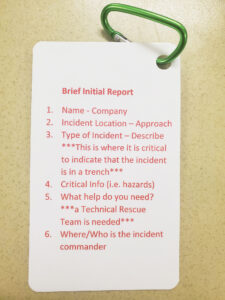In the first half of this year, 22 people died in trench-related accidents in the U.S., far exceeding the 15 trench-related fatalities for all of 2021, according to government data. This increase prompted the Occupational Safety and Health Administration (OSHA) to announce tougher trench-safety rule enforcement.

The deaths also drew attention to an innovative program by UWUA Local 254, part of the Michigan State Utility Workers Council (MSUWC), to teach gas workers how to respond to trench accidents and perform trench rescues. So far, almost 150 members from various MSUWC locals completed the training, and the plan calls for 1,400 Consumers Energy employees — both union and management — to complete the program.
The initiative started with Brian Carbary, Local 254 recording secretary and member for nine years, and Brandon Martiniuk, Local 254 vice president and an eight-year member. Several years ago, the pair became aware of training for Consumers’ electric workers on how to handle rescues for the specific hazards those workers face. There was no similar program for the company’s gas workers
“We looked at each other and said, ‘We don’t have anything like that. What happens to one of us if we get into a situation in a trench?’” said Martiniuk.
Trench danger and safeguards
Utility employees who work with buried lines and pipes often work in trenches and deal with the risk of a trench collapse. Other trench hazards include workers falling into trenches, being struck by objects that drop into a trench and being exposed to toxic atmosphere underground.
The rate of deaths in trench cave-ins is high because the walls can collapse with little warning and bury workers under tons of dirt that can rapidly suffocate or crush them. A cubic yard of dirt can weigh more than 3,000 pounds. OSHA cited a June accident in Texas in which two workers, aged 20 and 39, died when an unprotected trench more than 20 feet deep collapsed on them as they worked. Trench shields, which could have saved their lives, sat unused beside the excavation.
UWUA’s National Safety Committee member Brian Hannon noticed OSHA has stepped up job inspections of trench worksites. He reported that in one six-week period, the agency visited two Eversource job sites, both times conducting complete audits to ensure compliance.
Hannon relayed two recent incidents involving trenches. In the first, a contractor working on a gas valve lost his arm when a bucket truck slipped into the trench he was working in. In the other, a member was knocked into a trench from above. Fortunately, there was a shelf at 5 feet, but the trench was 20 feet deep.
OSHA rules require protective systems on trenches deeper than 5 feet. Trenches must also be inspected by a knowledgeable person, be free of standing water and atmospheric hazards and have a safe means of entering and exiting. Protective systems include excavation techniques that decrease the risk of cave-in as well as supports and shields to stabilize trench walls.
Motivated to improve worker safety, Carbary and Martiniuk began searching for trench rescue specialists and connected with a company that trains and accredits firemen to perform trench rescues, Emergency Response Solutions Inc. (ERSI).
ERSI designed a course tailored for utility workers. This one-day class was shorter than the multi-day training provided to firefighters and focused on meeting the workforce’s specific needs. A handful of union members did a three-day “train the trainer” course and became certified.
Winning company buy-in
The two men then embarked on a multi-year effort to convince Consumers to adopt the program. Consumers and MSUWC have a historically strong safety culture, so the pair had to fight the perception that there wasn’t a strong need for more training.

 The breakthrough in winning the company’s support happened about 18 months ago when an executive visited a job site and saw firsthand the gap in trench safety training. “To her credit, the next day, she sent someone to our headquarters, and they agreed to buy the course,” Martiniuk said.
The breakthrough in winning the company’s support happened about 18 months ago when an executive visited a job site and saw firsthand the gap in trench safety training. “To her credit, the next day, she sent someone to our headquarters, and they agreed to buy the course,” Martiniuk said.
Carbary and Martiniuk now train full-time for Consumers along with six other certified trainers. Two-person teams run the day-long classes for six to nine workers at a time. A second training location is being added to increase capacity. “We’re out to prove that if it’s union-run, it’s going to be better and more efficient and more professionally run than if the company were doing it,” Carbary said.
“The goal isn’t for us to become trench rescue experts, but rather it’s to put our members in the best position to receive rescue from the experts, along with some best practices of how we can help each other in a trench emergency,” said Martiniuk. He added, “We’re training to turn recoveries back into rescues.”
Every minute counts in trench collapses
Shaving minutes off the 911 response is a major focus of the training. The course teaches participants how to clearly convey information and talk to a 911 operator in a way that generates fast action.
“If we could share just one thing we’ve learned, it would be what to say to the 911 operator. Knowing the right words to say — what to say quickly and clearly — can save time and that means saving lives,” Martiniuk said.
Carbary added: “Every minute counts. Conveying the exact location, communicating any obstacles to accessing the location, letting operators know that there is an incident in a trench, those are all key words for 911 dispatchers to hear. Use trigger words to get the right response team to the site as soon as possible.”
Cecil Phillips agrees. He’s a member of 160-D at California Water, who serves on the water subcommittee of the UWUA National Safety Committee, and said, “Critical moments are lost in an emergency. If you can save even two minutes, you can save a life.” He feels this knowledge is even more critical for water workers given that they typically work in deeper trenches.
“In the water industry, when we work on an elevated tank, we have to notify the fire department in advance so they know that we’ll be at ‘this location, at this time,’ and if they get a 911 call they’ll know that we need an elevated truck. But we have no similar training for our below-grade work,” said Phillips.
Phillips is impressed with what’s happening in Michigan. “I’ve never heard of a training like these guys are doing.” He sees many benefits to having everyone on site know how to respond in an emergency, not just the person assigned in the job safety analysis (JSA). “Everyone has to be able to put on the safety response hat. What if the JSA person ends up being disabled in the trench?”
Hannon was equally impressed when he learned of the Michigan program: “I’ve been working at Eversource for 41 years and have never seen any type of trench rescue training offered.”
The MSUWC class also focuses on how best to assist a worker in peril and how to move an unconscious person in a trench with special grips and lifting techniques. Participants learn that leaving someone facedown poses the greatest danger. It’s better to seat them against a ladder and even better to strap them to a ladder with a specialized rescue strap. That can make it possible to pull the victim from the trench strapped to the ladder.
Cliff Deem, president of Ohio Local 425, is also a fireman and sees the training on positioning for rescue and what to say to 911 valuable. Deem’s employer, Aqua Ohio, requires all new hires to go through an eight-hour “competent person” course before they can work in a trench, but it does not involve any physical, hands-on training. It’s their practice to call the local fire department before they enter confined spaces, including trenches.
Martiniuk said, “We always tell everyone: We hope you never have to use anything you’ve learned here, but every trainee leaves knowing what to say to 911 and having a simple plan that can save a life. We tell them if you have a three-to-four-person crew, you can get anybody out in less than four minutes.”
Tenacity pays off
UWUA National Safety Director Scotty MacNeill hailed the importance of the training for all utility workers and the persistence of Carbary and Martiniuk. “This training is operable and applicable for water, gas and electric — anyone who deals with excavation. What I find amazing is that these guys saw a need and had to be really proactive and be really tenacious to move it forward,” he said.

